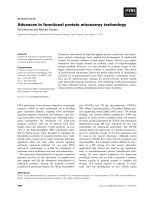ADVANCES IN WAVELET THEORY AND THEIR APPLICATIONS IN ENGINEERING, PHYSICS AND TECHNOLOGY doc
Bạn đang xem bản rút gọn của tài liệu. Xem và tải ngay bản đầy đủ của tài liệu tại đây (36.2 MB, 646 trang )
ADVANCES IN WAVELET
THEORY AND THEIR
APPLICATIONS IN
ENGINEERING, PHYSICS
AND TECHNOLOGY
Edited by Dumitru Baleanu
Advances in Wavelet Theory and
Their Applications in Engineering, Physics and Technology
Edited by Dumitru Baleanu
Published by InTech
Janeza Trdine 9, 51000 Rijeka, Croatia
Copyright © 2012 InTech
All chapters are Open Access distributed under the Creative Commons Attribution 3.0
license, which allows users to download, copy and build upon published articles even for
commercial purposes, as long as the author and publisher are properly credited, which
ensures maximum dissemination and a wider impact of our publications. After this work
has been published by InTech, authors have the right to republish it, in whole or part, in
any publication of which they are the author, and to make other personal use of the
work. Any republication, referencing or personal use of the work must explicitly identify
the original source.
As for readers, this license allows users to download, copy and build upon published
chapters even for commercial purposes, as long as the author and publisher are properly
credited, which ensures maximum dissemination and a wider impact of our publications.
Notice
Statements and opinions expressed in the chapters are these of the individual contributors
and not necessarily those of the editors or publisher. No responsibility is accepted for the
accuracy of information contained in the published chapters. The publisher assumes no
responsibility for any damage or injury to persons or property arising out of the use of any
materials, instructions, methods or ideas contained in the book.
Publishing Process Manager Vana Persen
Technical Editor Teodora Smiljanic
Cover Designer InTech Design Team
First published April, 2012
Printed in Croatia
A free online edition of this book is available at www.intechopen.com
Additional hard copies can be obtained from
Advances in Wavelet Theory and Their Applications in Engineering, Physics and
Technology, Edited by Dumitru Baleanu
p. cm.
ISBN 978-953-51-0494-0
Contents
Preface IX
Part 1 Signal Processing 1
Chapter 1 Real-Time DSP-Based
License Plate Character Segmentation
Algorithm Using 2D Haar Wavelet Transform 3
Zoe Jeffrey, Soodamani Ramalingam and Nico Bekooy
Chapter 2 Wavelet Transform Based Motion
Estimation and Compensation for Video Coding 23
Najib Ben Aoun, Maher El’arbi and Chokri Ben Amar
Chapter 3 Speech Scrambling Based on Wavelet Transform 41
Sattar Sadkhan and Nidaa Abbas
Chapter 4 Wavelet Denoising 59
Guomin Luo and Daming Zhang
Chapter 5 Oesophageal Speech’s Formants
Measurement Using Wavelet Transform 81
Begona García Zapirain, Ibon Ruiz and Amaia Mendez
Chapter 6 The Use of the Wavelet Transform
to Extract Additional Information on
Surface Quality from Optical Profilometers 99
Richard L. Lemaster
Chapter 7 Multi-Scale Deconvolution
of Mass Spectrometry Signals 125
M’hamed Boulakroune and Djamel Benatia
Part 2 Electrical Systems 153
Chapter 8 Wavelet Theory and Applications for
Estimation of Active Power Unbalance in Power System 155
Samir Avdakovic, Amir Nuhanovic and Mirza Kusljugic
VI Contents
Chapter 9 Application of Wavelet Transform
and Artificial Neural Network to Extract
Power Quality Information from Voltage
Oscillographic Signals in Electric Power Systems 177
R. N. M. Machado, U. H. Bezerra,
M. E. L Tostes, S. C. F. Freire and L. A. Meneses
Chapter 10 Wavelet Transform in Fault
Diagnosis of Analogue Electronic Circuits 197
Lukas Chruszczyk
Chapter 11 Application of Wavelet Analysis in Power Systems 221
Reza Shariatinasab and Mohsen Akbari and Bijan Rahmani
Chapter 12 Discrete Wavelet Transform Application to the Protection
of Electrical Power System: A Solution Approach for
Detecting and Locating Faults in FACTS Environment 245
Enrique Reyes-Archundia, Edgar L. Moreno-Goytia,
José Antonio Gutiérrez-Gnecchi and Francisco Rivas-Dávalos
Part 3 Fault Diagnosis and Monitoring 271
Chapter 13 Utilising the Wavelet Transform in Condition-Based
Maintenance: A Review with Applications 273
Theodoros Loutas and Vassilis Kostopoulos
Chapter 14 Wavelet Analysis and Neural
Networks for Bearing Fault Diagnosis 313
Khalid Al-Raheem
Chapter 15 On the Use of Wavelet Transform
for Practical Condition Monitoring Issues 353
Simone Delvecchio
Part 4 Image Processing 371
Chapter 16 Information Extraction and
Despeckling of SAR Images with
Second Generation of Wavelet Transform 373
Matej Kseneman and Dušan Gleich
Chapter 17 The Wavelet Transform
for Image Processing Applications 395
Bouden Toufik
and Nibouche Mokhtar
Chapter 18 Wavelet Based Image Compression Techniques 423
Pooneh Bagheri Zadeh, Akbar Sheikh Akbari and Tom Buggy
Contents VII
Chapter 19 Image Denoising Based on
Wavelet Analysis for Satellite Imagery 449
Parthasarathy Subashini and Marimuthu Krishnaveni
Chapter 20 Image Watermarking in Higher-Order Gradient Domain 475
Ehsan N. Arya, Z. Jane Wang and Rabab K. Ward
Chapter 21 Signal and Image
Denoising Using Wavelet Transform 495
Burhan Ergen
Chapter 22 A DFT-DWT Domain Invisible
Blind Watermarking Techniques for
Copyright Protection of Digital Images 515
Munesh Chandra
Chapter 23 The Wavelet Transform
as a Classification Criterion Applied to
Improve Compression of Hyperspectral Images 527
Daniel Acevedo and Ana Ruedin
Part 5 Applications in Engineering 537
Chapter 24 Robust Lossless Data Hiding by
Feature-Based Bit Embedding Algorithm 539
Ching-Yu Yang
Chapter 25 Time-Varying Discrete-Time Wavelet Transforms 557
Guangyu Wang, Qianbin Chen and Zufan Zhang
Chapter 26 Optimized Scalable Wavelet-Based
Codec Designs for Semi-Regular 3D Meshes 567
Shahid M. Satti, Leon Denis, Ruxandra Florea,
Jan Cornelis, Peter Schelkens and Adrian Munteanu
Chapter 27 Application of Wavelet Analysis
for the Understanding of Vortex-Induced Vibration 593
Tomoki Ikoma, Koichi Masuda and Hisaaki Maeda
Chapter 28 Application of Wavelets Transform in
Rotorcraft UAV’s Integrated Navigation System 613
Lei Dai, Juntong Qi, Chong Wu and Jianda Han
Preface
Wavelets are functions fulfilling certain mathematical requirements and used in
representing data or other functions. The basic idea behind wavelets is to analyze
according to scale. Wavelets received considerable attention in the last years because
they are very appropriate for application in practical problems in areas of
Engineering, Physics and Technology.
The book is organized in five main sections denoted as Signal Processing, Electrical
Systems, Fault Diagnosis and Monitoring, Image Processing and Applications in
Engineering.
The wavelet method is used in this book to extract more information than the standard
techniques from a given complex signal and it has capabilities for the deconvolution
framework. Applications of wavelet transform to the image processing, audio
compression and communication systems are also reported.
The applications of wavelet transform in the field of power system dynamics and
stability, in fault diagnosis of analogue electronic circuits as well as for practical
condition monitoring issues are covered by this book. In addition the application of
wavelet analysis combined with artificial neural networks as automatic rolling bearing
fault detection and diagnosis is illustrated. The use of the wavelet transform to the
denoising process is an important chapter of this book. The reader can see how the
wavelet transform was used as a classification criterion applied to improve the
compression of the hyper-spectral images.
The last chapter of the book presents some specific applications of the wavelet
transform in engineering, e.g. to robust lossless data hiding by feature-based bit
embedding algorithm, for the understanding of vortex-induced vibration, in rotorcraft
UAV's integrated navigation system. Also, a constructive design methodology for
multi-resolution- scalable mesh compression systems is presented.
The chapters of this book present the problems for which wavelet transform is best
well-suited, indicates how to implement the corresponding algorithms efficiently, and
finally show how to assign the appropriate wavelets for a specified application.
X Preface
Researchers, working in the field of the wavelet transform, will find several open
problems being mentioned within this book. Both theoretical considerations as well as
the corresponding applications are clearly presently in such a way to be
understandable by a large variety of readers.
Dumitru Baleanu
Cankaya University, Faculty of Art and Sciences
Department of Mathematics and Computer Sciences, Ankara,
Turkey
Institute of Space Sciences, Magurele-Bucharest,
Romania
Part 1
Signal Processing
1
Real-Time DSP-Based
License Plate Character Segmentation
Algorithm Using 2D Haar Wavelet Transform
Zoe Jeffrey
1
, Soodamani Ramalingam
1
and Nico Bekooy
2
1
School of Engineering and Technology, University of Hertfordshire,
2
CitySync Ltd., Welwyn Garden City,
UK
1. Introduction
The potential applications of Wavelet Transform (WT) are limitless including image
processing, audio compression and communication systems. In image processing, WT is
used in applications such as image compression, denoising, speckle removal, feature
analysis, edge detection and object detection. The use of WT algorithms in image processing
for real-time custom applications may require dedicated processors such as Digital Signal
Processor (DSPs), Field Programmable Gate Arrays (FPGAs) and Graphics Processing Units
(GPUs) as reported in (Ma et al., 2000), (Benkrid et al., 2001) and (Wong et al., 2007)
respectively.
The interest in this chapter is the use of WT in image objects segmentation, in particular, in
the area of Automatic Number Plate Recognition (ANPR) also known as License Plate
Recognition (LPR). ANPR algorithm is normally divided into three sections namely LP
candidate detection, character segmentation and recognition. The focus of this chapter is on
the use of Haar WT algorithms for License Plate (LP) character segmentation on a DSP using
Standard Definition (SD) and High Definition (HD) images. This is an extension of the work
reported in (Musoromy et al., 2010) by the authors, where Daubechies and Haar WT are
used to detect image edges and to enhance features of an image to detect a LP region that
contain characters. The work in (Musoromy et al., 2010) demonstrated that 2D Haar WT is
favourable in ANPR using DSP due to its ability to operate in real-time. The drive here is the
consumer interest in real-time standalone embedded ANPR systems. The next section
describes the proposed LP character segmentation algorithm.
The chapter organisation is as follows: Section (2) reviews dedicated hardware for WT-
based image processing algorithms. Section (3) gives a review of image processing
techniques using WT and in ANPR application. Section (4) presents the proposed LP
character segmentation algorithm based on 2D Haar WT edge detector. Section (5) presents
experimental setup. Section (6) presents results and analysis. Section (7) gives conclusion
and Section (8) gives references.
Advances in Wavelet Theory and Their Applications in Engineering, Physics and Technology
4
2. Dedicated hardware for WT review
The objective of this work is to investigate a suitable hardware that is able to perform image
processing algorithms using WT in real time. Processing an image with the WT filter is
faster in terms of computational cost in applications such as edge detection where a single
filter is capable of producing three types of edges in comparison to standard methods where
more than one filter masks are required to achieve the same results. In this section we
review the special hardware dedicated for WT including DSPs, FPGAs and GPUs.
GPUs provide programmable vertex and pixel engines that accelerates algorithm mapping
such as image processing. An example of a cost effective SIMD algorithm that performs the
convolution-based DWT completely on a GPU using a normal PC (baseline processor) is
reported by Wong (Wong et al., 2007). It is reported, the algorithm unifies forward and
inverse WT to an almost identical process for efficient implementation on the GPU through
parallel processing (Wong et al., 2007). This demonstrate that GPUs are capable of
processing WT algorithms cost effectively, however it is not suitable for our application,
which is PC independent.
An example of a scalable FPGA-based architecture for the separable 2-D Biorthogonal
Discrete Wavelet Transform (DWT) decomposition is presented by (Benkrid et al., 2001).
The architecture is based on the Pyramid Algorithm Analysis, which handles computation
along the border efficiently by using the method of symmetric extension using Xilinx Virtex-
E (Benkrid et al., 2001). FPGA’s are suitable for real-time embedded applications due to their
parallel processing abilities.
DSPs are also reported to be powerful and portable for embedded systems. An example
system by Desneux and Legat (Desneux & Legat, 2000) show a DSP with an architecture
designed specifically for DWT. Their DSP design stops any wait cycles during algorithm
execution by using a bi-processor organization. It is able to perform a 3-stage
multiresolution transform in real time. Their DSP is fully programmable in terms of filters
and picture format as well as being capable of image edge processing.
Using a floating-point DSP, Patil and Abel (Patil & Abel, 2006) used redundant wavelet
transform as a tool for the analysis of non-stationary signals as well as the localization and
characterization of singularities. Their work focused on producing an optimized method for
the implementation of a B-spline based redundant wavelet transform (RWT) using a (DSP)
for integer scales leads to an improvement in the execution speed over the standard method.
A DSP-based edge detection comparison is explained in (Abdel-Qader & Maddix, 2005)
where three edge detection algorithms performance on DSP are compared using Canny,
Prewitt and Haar wavelet-based. The reported outcome is that the Haar wavelet-based edge
detector performed best in terms of SNR in noisy images. The authors recommended post-
processing of the output edges to make them more optimal.
The review favours DSPs as a suitable choice for our ANPR application. In addition,
following successful results in LP detection using a DSP as reported in (Musoromy et al.,
2010) using WT, this work extends the use of WT in the LP character segmentation
investigation of SD and HD images using a Texas Instrument’s C64plus DSP with minimum
of 600MHZ clock speed and 1MB of RAM (TI, 2006).
Real-Time DSP-Based License Plate
Character Segmentation Algorithm Using 2D Haar Wavelet Transform
5
3. Image processing and ANPR using WT
This section gives a review of interesting ANPR algorithms using WT. The use of discrete
wavelet transform (DWT) (described in Section 4.2) in ANPR is reported by Wu (Wu et al.,
2009) in LP detection process. The methodology works by applying the “high-low” subband
feature of 2D Haar DWT twice to increase the recognition of vertical edges while decreasing
background noise in real world applications. The authors noted an increase in the ease of
location and extraction of the license plate by orthogonal projection histogram analysis from
the scene image in comparison with the vertical Sobel operator (a single level 2D Haar
DWT) used in most License Plate Detection Algorithms. However, due to the down-
sampling used in this technique, it is only suitable for use with high-resolution images or
cameras in close proximity to the plate (Wu et al., 2009).
An interesting algorithm is proposed by Roomi (Roomi et al., 20011) that consists of two
main modules, one for the rough detection of the region of interest (ROI) using vertical
gradients and another for the accurate localisation of vertical edges using the vertical
subband feature of 2D discrete wavelet transform (DWT). This is followed by the
identification of the orthogonal projection histogram for the extraction of the license plate.
This method combines the advantage of relatively short runtimes whilst still maintaining
accuracy, across a range of vehicle types. The authors reported that the number plates
recognition accuracy was reduced where the plates were tilted (Roomi et al., 20011).
WT is also used in the simplification of skew correction in order to reduce computational
demands to make the process suitable for real time applications (Paunwala et al., 2010). The
method uses two levels WT to extract a skewed feature image of the original LP image,
which is then transformed into a binary image from which the feature points can be
identified by applying a threshold. These feature points help identify the angle at which the
plate is tilted using principal component analysis, from which the correction to the whole
plate image can be applied (Paunwala et al., 2010).
To conclude, the use of WT and the advantages are widely reported in the ANPR algorithms
and therefore the focus of this chapter is the suitability of WT in HD images and DSPs for
real time performance in LP character segmentation but firstly, LP detection process used in
this work is summarized in the following section.
3.1 LP detection algorithm
The LP detection is the first part of an ANPR algorithm, which gives the rectangle region
that contains characters. The plate detection algorithm used here is divided into four parts.
These are input image normalization, edges enhancement using filters, edges finding and
linking to rectangles using connected component analysis (CCA) and plate candidate
finding (Musoromy et al., 2010). We have used the edge finding method in (Musoromy et
al., 2010) to verify the presence of an edge. The edge finding method works by scanning the
image and a list of edges is found using contrast comparison between pixel intensities on the
edges’ boundaries using the original gray scale image. The WT methodologies described by
the authors in the literature above are mainly applied to LP detection process and
benchmarked on baseline processors. In this chapter, we have expanded the use of Haar
based edges in LP character segmentation algorithm. In addition, we have applied these
Advances in Wavelet Theory and Their Applications in Engineering, Physics and Technology
6
edges in HD images and benchmarked their DSP and baseline processor performance to
meet real-time requirement.
4. LP character segmentation algorithm based on 2D Haar WT edge detector
In image processing, edge detection is the key pre-processing step for identifying the
presence of objects in images. This is achieved by identifying the boundary regions of an
object. There are several robust edge detection techniques widely reported in the literature
from early works by Canny (Canny, 1986) and some of the most recent, such as Palacios
(Palacios et al., 2011). However, in custom applications, such as embedded ANPR system
where both real-time performance and LP recognition success is demanded, a choice of
good edge detector that balances these two factors is important.
The proposed algorithm is based on 2D Haar WT edge detector, which is shown to enhance
image edges and improve LP region detection in Musoromy (Musoromy et al., 2010). The
algorithm used for LP region detection and extraction explained in Section 3.1 is adapted to
perform LP character segmentation. The main reasons for adapting the Haar WT for
character segmentation are:
The ability of Haar WT to detect three types of edges using a single filter while
traditional methods such as Sobel would require more than one mask for the operation
Simplicity of the algorithm and its suitability in real-time application
The following sections describe the LP character segmentation algorithm based on a 2D
Haar WT edge detector starting with the WT definition.
4.1 Wavelet Transform
In image processing, we can define a function f(x,y) as an image signal and Ψ(x,y) as a
wavelet. A wavelet is a function of Ψ Є L
2
(R) used to localise a given function such as f(x,y)
in both translation (u) and scaling (s). The family of wavelet is obtained by translation and
scaling in time (t) using individual wavelet as given in equation (1) and (2) by (Mallat, 1999):
,
1
ΨΨ
us
tu
t
s
s
(1)
Wavelets are useful in transforming signals from one domain to another, giving useful
information for easier analysis hence the term Wavelet Transform which can be defined as:
*
1
Wf u,s ()Ψ
tu
f
tdt
s
s
(2)
This represents a Continuous WT (CWT) of a function f at scales s>0 and translated by u Є
R, which can also be explained as a 1D. When processing an image, we can apply this
wavelet in the x direction where Ψ Є L
2
(R) as follows:
*
1
Wf u,s ()Ψ
xu
f
xdx
s
s
(3)
Real-Time DSP-Based License Plate
Character Segmentation Algorithm Using 2D Haar Wavelet Transform
7
The x and y directions can represent rows and columns of an image f(x,y) Є L
2
(R
2
) and
therefore we can also apply the CWT in 2D using wavelet Ψ Є L
2
(R
2
) as (Palacios et al., 2011):
*
s
yv
1xu
Wfu,v f(x,y)Ψ ,
sss
(4)
We can rewrite equation (4) with dilation factor s as
s
y
1x
Ψ x,y Ψ ,
sss
(5)
and
Θ Θ
Ψ (x,
y
) Ψ (x,
y
)
as a convolution
Θ
s
s
Wfu,v f*Ψ u,v (6)
The large number of coefficients produced by CWT makes it necessary to discretely sample
signals in order to simplify signal analysis process and also for the use in real-time
applications such as image processing. This process is technically known as discrete wavelet
transform (DWT).
4.2 Discrete Wavelet Transform
Discrete wavelet transform (DWT) or fast wavelet transform (FWT) is a specialised case of
sub-band filtering, where DWT is a sampled signal of size N using scale at
2
j
s
for j < 0
and time (for scale 1) (Mallat, 1999). Using the wavelet equation:
1
Ψ [] Ψ
j
n
n
s
s
(7)
DWT is also a circular convolution where:
Θ *
Ψ [n] Ψ [n]
j
(8)
The convolution of signal f and the wavelet is written as follows:
N1
* Θ
j
m0
Wf n,s fmΨ mn f*Ψ [n]
(9)
Calculations of DWT is done using filter bank which can be a series of cascading digital
filter. Implementing the DWT using filter banks entails the signal sampled being passed
through high-pass and low-pass filters simultaneously to produce detailed and
approximated confidents respectively (Qureshi, 2005). The high frequencies DWT are
contained similar to equation (9) as follows:
N1
* Θ
High j
m0
Wfn,s fmΨ mn f*Ψ [n]
(10)
Advances in Wavelet Theory and Their Applications in Engineering, Physics and Technology
8
The low frequencies are contained in equation (12), in the computation of periodic scaling
filter where the scaling function in equation (11) is sampled with scale z and integer k
(Mallat, 1999). Let
Θ *
k
Φ [n] Φ [n]
be a convolution:
1
Φ [] Φ
k
n
n
s
s
(11)
N1
* Θ
Low k
m0
Wfn,z fmΦ mn f*Φ [n]
(12)
The high-pass filter
HP
hn
is formed from the low pass filter
LP
hn
using the following
equation (Qureshi, 2005):
n
HP LP
hn 1hN1n,n0, ,N1
(13)
where h is the filter and N is the number of taps in the low-pass filter. If the length N of
analysis low-pass filter is 4, and
LP 0 1 2 3
h h,h,h,h
(14)
Applying equation (13), we obtain:
HP 3 2 1 0
h h, h,h, h
(15)
To analyse DWT the input signal f
(x,y)
[n] is passed through both filters explained in
equations (10) and (12) to give filtered output y[n]. The output is then decimated or down
sampled by a factor of two (Qureshi, 2005). Decimation means every other sample is taken
from an input to form an output such that:
(,)
y
[n] [2 ]
xy
fn
(16)
The analysis of DWT with the resulting coefficients is shown in figure 1.
Fig. 1. Single level DWT (analysis stage of
fx,
y
) (Mallat, 1999)
Real-Time DSP-Based License Plate
Character Segmentation Algorithm Using 2D Haar Wavelet Transform
9
The 2D DWT of an image function f(x,y) of the size M x N can be written using wavelet
functions in equation (17) and (18) (Mallat, 1999)
0
00
0
j
jj
2
j,m,n
φ x,y 2 φ(2 x m,2y n)
(17)
j
jj
2
j,m,n
ψ x,y 2 ψ(2 x m,2y n)
(18)
as follows:
0,m,n
MN
φ 0j
x0y0
1
Wj,m,n fx,y φ (x,y)
MN
(19)
MN
ii
ψ j,m,n
x0y0
1
Wj,m,n fx,y ψ (x,y)
MN
(20)
where i= {1, 2, 3}.
At the end of analysis stage, the transformed image can be reconstructed back to an original
image or to a new image using the inverse of DWT (IDWT). The reconstruction is a process
of upsampling the wavelet coefficients by a factor of two and passed through reversed low-
pass (
LP
g
) and high-pass (
HP
g
) filters simultaneously (Qureshi, 2005). The reconstruction
to an original image is demonstrated in figure 2.
Fig. 2. Single level IDWT (reconstruction of
fx,
y
) (mallat, 1999)
4.3 2D Haar WT
There is a countless number of wavelets available in the wavelet family with more being
reported in the literature of wavelets (Mallat, 1999). For this application, we are interested in
the simplest but efficient DWT. The Haar is the first and simplest WT in the family of
Advances in Wavelet Theory and Their Applications in Engineering, Physics and Technology
10
wavelets (Haar, 1911). Haar WT is derived starting with Haar wavelet function defined
as:
1
10
2
1
Ψ(x) 1 1
2
0
x
x
Otherwise
(21)
and in 1D
j
j,k,
ψ x ψ(2 x k)
(22)
Its scaling function
φ(x)
can be defined as:
101
φ(x)
0
x
Otherwise
(23)
The Haar matrix can be obtained using the wavelets defined in equations (17) to (20) and
applying the formula in (10) to form high-pass filter from the low pass filter. The simplest
Haar 2x2 matrix when N is 2 is as follows:
2
1 1
H
11
(24)
and when N is 4 to give Haar 4x4 matrix as follows:
4
1111
11 1 1
H
1100
00 1 1
(25)
The Haar WT filter can be derived by transformation, for example transforming
2
H
to:
2
1 1
1
H
11
2
(26)
The 2D Haar WT is computed similarly as shown in equations (14) to (17). The result of
applying single level 2D Haar WT in an image is a decomposition of an image into four
bands including a low-pass filtered approximation “low-low” (LL) sub image, which is the
smaller version of the input image and three high-pass filtered detail subimages, “low-high”
(LH), “high-low” (HL) and “high-high” (HH). The subbands and shown in figure 3 and the
corresponding resulting images are shown in figure 4. In addition the images can also be
discomposed using different levels with a series of cascading filter bank to produce a multi-
resolution (Mallat, 1989).
Real-Time DSP-Based License Plate
Character Segmentation Algorithm Using 2D Haar Wavelet Transform
11
LL LH
HL HH
Fig. 3. A Decomposed image into four bands using 2D Haar WT
Fig. 4. Single level Haar WT decomposition (enhanced for display), the top left image is the
LL, the top right image is LH, the bottom left image is HL and the bottom right image is the
HH.
4.4 2D Haar WT based edge detector
The main advantage of applying 2D DWT such as Haar to an image is that it decomposes it
to four sub images as seen in figure 4, which is mathematically less intensive operation and
more suitable for our application. The suitable edges for our application are obtained by
applying a 2D Haar WT (2x2) on an image f(x,y) to obtain high and low frequency
subimages as shown by the following equation
LL LH HL HH
DWT
f x,y a x,y dx,ydx,ydx,y
(27)
where d and a are the detailed and approximate components. The low frequency subimage
LL
(a (x,
y
))
and the “high-high”
HH
(d (x,
y
))
subimage are then removed from equation (27)
to give the vertical
LH
(d (x,y))
and horizontal
HL
(d (x,y))
components
HV
(d (x, y))
.
At this stage, the edges can be computed using reconstruction through the use of wavelet
transform modulus of
LH HV
dx,
y
andd(x,
y
)
and then followed by the calculations of
Advances in Wavelet Theory and Their Applications in Engineering, Physics and Technology
12
edge angles (Mallat, 1999). Alternatively, an estimate of the wavelet transform modulus of
the horizontal and vertical components without taking into account the angle of the DWT as
reported in (Qureshi, 2005). In this case, the wavelet modulus is compared to the local
average. This is the approximation to the wavelet modulus maxima which is then compared
to a global threshold dynamically calculated from the coefficients of the estimated modulus
of the detail coefficients.
In our application, we choose to perform reconstruction on
HV
d(x,
y
)
using inverse DWT
(IDWT) using 2D Haar WT to obtain horizontal and vertical edges
HV
(E (x,
y
))
. This is
computationally efficient on a DSP and it also provides enough edge details for our
application. This process is shown in figure 5.
Fig. 5. A reconstruction of
HV
d(x,
y
)
into
HV
Ex,
y
using 2D IDWT
The absolute edges are then computed where
HV HV
Ex,
y
E(x,
y
)
and then post
processing is applied to the edges to make them more prominent and inversion for optimal
display is performed using an 8-bit dynamic range. Our application demands more edges
and less noise therefore, an automatic thresholding method called autonomous percentile
(P-tile) thresholding followed by histogram analysis (Qureshi, 2005).
P-tile histogram thresholding is used here due to the fact that the texts inside the license
plate region covers a known region 1/p of the total image. The threshold is automatically
detected such that 1/p of the image area has pixel intensities less than some threshold T
knowing that the text is dark and the background is white or the other way around, which is
easily determined through inspection. Starting with the normalized histogram is a
probability distribution:
g
n
pg
n
(28)
Real-Time DSP-Based License Plate
Character Segmentation Algorithm Using 2D Haar Wavelet Transform
13
That is, the number of pixels n
g
having intensity g as a fraction of the total number of pixels
n. The intensity level (c) of g is given as,
0
()
g
cg pg
(29)
Finally the threshold T is set such that
1
cT
p
(30)
The results from reconstruction of the vertical and horizontal edges, absolute edges and
prominent edges using single level decomposition and reconstruction are shown in figure 6
and figure 7 respectively.
(a) (b)
Fig. 6. The original image is shown in (a) and the resulting image from reconstruction using
single level IDWT is shown in (b)
(a) (b)
Fig. 7. Absolute edges are shown on image (a) and image (b) shows prominent edges
(a) (b)
Fig. 8. The original license plate candidate image is shown in (a) and prominent edges in the
LP candidate are shown in (b) using single level decomposition









